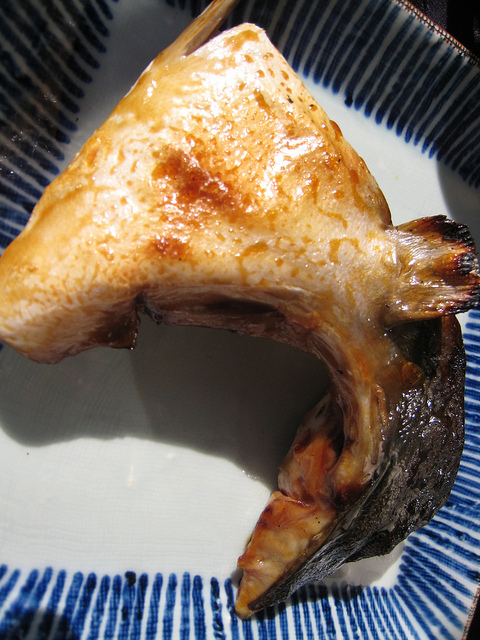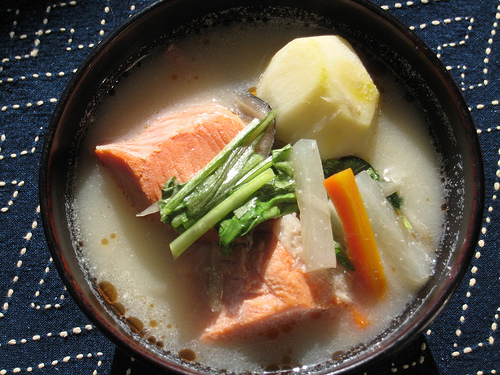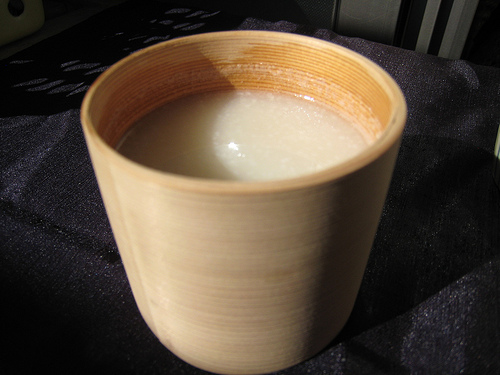Sakekasu (sake lees) article and recipe in The Japan Times, plus amazake recipe
In today's Japan Times, I have an article about the use of sakekasu, the lees (leftover bits) of the sake making process, in cooking. Sake is a fermented-grain beverage, not unlike beer, and sakekasu is a delicious and very useful by-product.
In the main sakekasu article, I also go into an explanation of why sake and mirin are used in Japanese cooking so much. This is a more detailed followup of sorts to my post here from 3 years ago, The role of alcohol, onion and ginger in Japanese meat dishes. One of the main reasons to use sake or mirin in cooking is to get rid of the gamy flavor of meat or fish, but the other reasons are very important too, especially to draw out the umami in food. (This is why, even though you can use a bit of sugar in lieu of sake or mirin in recipes, sugar is not really a perfect substitute at all. The only reasons for avoiding the use of sake or mirin is if you can't use either one for dietary or religious reasons, or if your country restricts their sale, even cooking sake or mirin, which are not really drinkable.)
If you're in Japan, you can find sakekasu easily at supermarkets. If you have a favorite artisanal sake maker, ask them if they have some sakekasu to sell you - if you like their sake, you'll love their sakekasu too. If you don't live in Japan though, find it sakekasu a bit hard to come by. (Note that I orient my Japan Times articles and recipes to people living in Japan, who are the main readership for the paper, so I do write more about ingredients that may not be that easy to get outside of Japan. On my blogs I write mostly for a not-living-in-Japan audience.) If you live near a Japanese grocery store and don't see it for sale, ask them if they have it or can get it for you. I have seen it for sale at a few stores, even at my Zürich 'local', Nishi's Japan Shop. It will be in the refrigerated or freezer section, in bags or tubs. (Don't confuse it wtih koji, which is a whole other thing.) Or, you may be able to buy readymade kasuzuke or fish marinated in sakekasu - I saw some delicious looking kasuzuke fish for sale at Shin Nippon-do in Roslyn, New York recently. I absolutely love kasuzuke; it has a wonderful aroma and distinct sweet-savory flavor. I prefer it over miso marinade, which has been popularized by Nobu and other places. I hope you can try kasuzuke, either homemade or storebought! The main Japan Times article has instructions for making your own kasuzuke. Narazuke, an ancient pickle that is a speciality of the city of Nara, is also something worth seeking out.
Here's a photo of the grilled kazuzuke of kama or the fish head part of a large snapper. The fish head is the most delicious part of a fish, by the way, even if it looks rather funny.

The accompanying recipe is for making kasujiru, a soup that uses sakekasu with a bit of miso. You can make kasujiru with 100% sakekasu too, but I prefer a bit of miso in this case. It's hearty and very, very warming on a cold wintry night. Here's another shot of it.

And yes, even though sakekasu does have alcohol in it, most of it evaporates with the heat of cooking, and Japanese children eat kasuzuke and kasujiru all the time.
As I mention in the article, recently there was a run on sakekasu in Japan because of a TV report that touted its health benefits...or to be specific, its cholesterol-lowering qualities, which got interpreted in the media as "OMG sakekasu is good for dieting whee!", as often happens. (See also: The Natto Diet, which turned out to be a bogus story, and The Morning Banana Diet.) The source of the stories, a popular science-oriented program on NHK called Tameshite Gatten! (which roughly translates as Let's Test It Out to Understand!) is a bit more credible than the natto and banana stories though. In any case, if you can get hold of sakekasu, I hope you give it a try!
Another use of sakekasu is to make amazake, a sweet, thick hot low-alcohol drink rather like eggnog. Amazake is consumed during the cold winter months - it's thought to help ward off colds - and is a traditional part of the Girl's Day Festival on March 3rd. Amazake is usually made from koji, steamed rice with sake-making spores, but using sakekasu is a lot easier and foolproof, if slightly higher in alcohol.
Recipe: Quick Amazake

For 4 servings (4 cups)
- 4 oz / 120g pressed sakekasu
- 2 1/2 cups / 600 ml water
- 4 tablespoons sugar
- a pinch of salt (optional, helps to draw out the sweetness)
- 1 to 2 tablespoons grated fresh ginger, or to taste
If your sakekasu is rather solid, chop it up with a knife (it will be rather like soap). Or, just crumble it up with your hands. Put the sakekasu in a pot with the water, and allow to stand for several hours or overnight. The sakekasu will melt in the water - if it hasn't melted totally, stir it around until you have a milky looking liquid.
Put the pot on the stove, and add the sugar. Stir while heating over a medium-low heat, until it's warm and bubbling slightly. Add the salt and the grated ginger. Serve while hot with a spoon or chopsticks to stir while drinking.
If you enjoyed this article, please consider becoming my patron via Patreon. ^_^

 Welcome to Just Hungry, where we serve authentic Japanese recipes and more! I'm
Welcome to Just Hungry, where we serve authentic Japanese recipes and more! I'm 














Comments
E from the Medi...
29 January, 2011 - 08:33
Permalink
Re: Sakekasu (sake lees) article and recipe in The Japan ...
This is so great - I love reading your blog(s) and learning new things all the time!
Unfortunately for me, Japanese food items are scarce where I live (can you believe we only have 1 kind of tofu here?) but I do what I can with what I've got.
Could you perhaps elaborate some more on the Girl’s Day Festival on March 3rd? about the holiday, the customs and of course the traditional foods.
Thanks!
misa
29 January, 2011 - 23:17
Permalink
mirin
hello maki! I live in NYC and buy Japanese food all the time, but for some reason I cannot find mirin made without corn syrup. I can't imagine that it doesn't exist... any suggestions?
maki
30 January, 2011 - 01:20
Permalink
Re: mirin
Are you sure you're getting hon mirin and not aji-mirin (mirin flavored condiment)? Hon mirin really should not have added sweeteners, since the sweetness comes from the way mirin is made - some of the alcohol content is converted to sugars. Try at Mitsuwa in Edgewater, NJ perhaps.
misa
31 January, 2011 - 21:04
Permalink
Re: mirin
Thanks Maki! I was just searching some online Japanese grocery sites for hon mirin and the ones I found available in the US have added sugar, glucose syrup, corn syrup, etc. I'll check out Mitsuwa for sure!
Julie S.
30 January, 2011 - 00:19
Permalink
Re: Sakekasu (sake lees) article and recipe in The Japan ...
Read this article and found it very interesting, but having no brewers in Norway I just shrugged it off to only that.
But, today I learned we have one brewer, and they had their first batch finished around christmas. They have been contacted regarding this intriguing goo, and my friends love amazake, so thank you so much for the recipe.
Kathie
30 January, 2011 - 03:06
Permalink
Re: Sakekasu (sake lees) article and recipe in The Japan ...
I have never heard of this. I can't imagine where I'd find it in my city, but I will look. Love the miso soup recipe!
Kirsten
30 January, 2011 - 11:57
Permalink
Re: Sakekasu (sake lees) article and recipe in The Japan ...
What a timely post! I just came back from 3 weeks over in osaka and tried Amazake at a japanese friend's house. It was amazing and I wanted to make it at home. Thanks for the recipes!
Miyuki Mouse
4 February, 2011 - 04:28
Permalink
Re: Sakekasu (sake lees) article and recipe in The Japan ...
You have impeccable timing, Maki! There's an artisanal sake maker in Vancouver, Canada that I visited a few years ago, and I found the sakekasu that I bought there in my fridge just the other week. (I'd forgotten about it.) I've been too scared to check it's condition though ;)
Will definitely try some of these recipes if it seem to be in a usable state...
crommr
12 September, 2013 - 15:01
Permalink
Re: Sakekasu (sake lees) article and recipe in The Japan ...
The amazake was very very tasty!
I need to make more sake this winter so I would have sakekasu.
Still have a bit in a jar left, will try the soup, looks delicious.
Adam K
4 March, 2014 - 16:19
Permalink
Re: Sakekasu (sake lees) article and recipe in The Japan ...
I am starting my next sake batch next week. My wife's friends are looking more to the leftover sake-kasu than to the sake :D
(we live in Edinburgh in the UK).